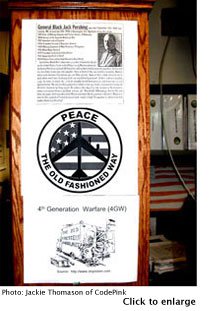California National Guard Story Grows Stranger
July 07, 2005
The story about the California National Guard’s surveillance of a Mother’s Day protest gets curiouser and curiouser.
The protest was co-sponsored by CodePink, the Peninsula Raging Grannies, and Gold Star Families for Peace. Internal Guard e-mails, obtained by the San Jose Mercury News, revealed that a new intelligence unit within the Guard was monitoring the demonstration.
State Senator Joseph L. Dunn, who chairs the subcommittee that governs the Guard’s budget, had never been informed of the existence of this unit, he says. Once he read about it, he demanded all documents that related to it, and to the surveillance of the Mother’s Day protest.
After he made that request, “the California National Guard erased the computer hard drive of a retiring colonel who oversaw the fledgling project,” according to Mercury News reporter Dion Nissenbaum.
The Guard’s director of public affairs, Lieutenant Colonel Douglas Hart, says this was routine.
“It is standard operating procedure for us to take computers from people who have left our employ, clean them, and reissue them,” he says.
Senator Dunn isn’t buying that.
“Our inside sources say that excuse is nonsense,” Senator Dunn tells The Progressive, adding that his sources say that such a procedure was not in place for the last 100 departing employees.
In any event, Hart says the computer and its files have now been retrieved. “It is my understanding we have got that computer back, and it appears we will be able to get back any information that was on it,” he says. “We do have that computer secured now.”
But Dunn is not satisfied by that assurance.
“We have our own IT guys,” Senator Dunn says. “I’m not willing to rely on copies of what the Guard claims was on the hard drive. They have not yet agreed to give me access to the hard drive itself.”
Dunn considers this “an obstruction of justice,” he says. “I have under consideration whether to refer this to California’s Attorney General Bill Lockyer.”
One other peculiar thing has come up. On July 5, the Guard met with representatives of CodePink and the Raging Grannies. By most accounts, it was an uneventful meeting, with Colonel Hart being very polite and solicitous, even as the activists asked pointed questions. Then they all had tea and cookies together.
But just before the activists left, a couple of Raging Grannies were disturbed by a poster on the wall of the conference room they were in.
“It was a binder-sized piece of paper that was xeroxed,” says Gail Sredanovic. “It had a picture of General Pershing with a long account of really sadistic things he did to Muslim prisoners. He tied 50 prisoners to execution stakes and in front of them he slaughtered a pig and dipped his bullets in the pig’s blood and killed 49 out of 50 Muslims, who would not be able to get into heaven because they had been contaminated by the pig’s blood. The conclusion was something like, ‘Pershing had no more trouble with the Muslims, and we need somebody like him today.’ ”
(After 9/11, a chain letter on the Internet was circulating with versions of this Pershing story, which may actually be apocryphal. See breakthechain.org or urbanlegends.com.)
Sredanovic was taken aback.
“The idea that this would be posted with a recommendation that we need to do likewise was just over the top in terms of baseness,” she says. “It reflects a mentality of not only condoning killing people but killing them in a sadistic way.”
Ruth Robertson, the other Raging Grannie who saw the poster, says the anti-Muslim aspect of the poster is what really got to her.
Colonel Hart says he’s heard of this General Pershing story. But he says he can’t confirm that the poster hangs in the headquarters of the California National Guard.
“I’m not familiar with this particular poster,” he says. “I’m not saying it’s not up there. I just don’t know.”
